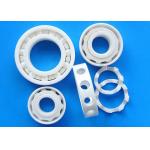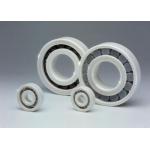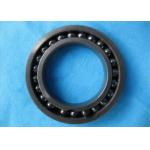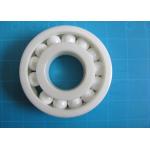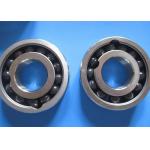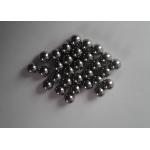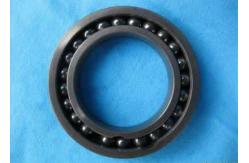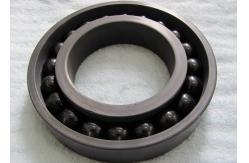Full Complement Balls Of Si3N4 Ceramic Bearings, Full Ceramic
Bearings
Full Ceramic Bearings of full complement balls of Si3N4 material
has an add-ball gap on its side. Because using no cage design, Full
Complement Balls Of Si3N4 Ceramic Bearings is able to install more
ceramic balls than the standard construction, so the heavier radial
load ability could be increased more. In addition, to avoid the
limited of the cage material, Full Complement Balls Of Si3N4
Ceramic Bearings has more corrosion resistance and higher
temperature application than the full ceramic bearing of ceramic
cage. This series of Full Complement Balls Of Si3N4 Ceramic
Bearings is not for high-speed circumgyration, so the side with gap
shouldn’t be installed on enduring axial load side. As there are
add-balls gaps in the inner and outer rings, Full Complement Balls
Of Si3N4 Ceramic Bearings couldn’t be used in more axial load
application. The highest temperature of recommendation is 1000℃.
| Comparison of bearing material technical data |
| Technical data | unit | GCr15 | 9Cr18 | Si3N4 | AL203 | ZrO2 |
| Density | g/cm³ | 7.8 | 7.9 | 3.2 | 3.95 | 6 |
| a Coefficient of expansion | 10^-6/℃ | 11 | 17 | 3.2 | 9.1 | 10.5 |
| E modulus of elasticity | Gpa | 208 | 200 | 320 | 380 | 210 |
| μ Poisson ratio | | 0.3 | 0.3 | 0.26 | 0.27 | 0.3 |
| HV Hardness | | 800 | 700 | 1700 | 1800 | 1300 |
| δ Flexural strength | Mpa | 2400 | 2600 | 900 | 220 | 1000 |
| δ Compressive Strength | MPa | | | 2000 | 1500 | 3500 |
| Kc Impact strength | Nm/cm² | 20 | 25 | 7 | 3.5 | 11 |
| λ Thermal conductivity | W/mk | 30-40 | 15 | 3.5 | 25 | 2.5 |
| Ω Specific resistivity | mm²/m | 1 | 0.75 | 10^18 | 10^8 | 10^5 |
| Specific heat | J/KgK | 450 | 450 | 800 | 880 | 400 |
| Application temperature | ℃ | 120 | 150 | 1000 | 1850 | 800 |
| Anti-corrossion | | No | poor | Good | Good | Good |
| Cycle stress | | 10*10^6 | 10*10^6 | 50*10^6 | 30*10^6 | 50*10^6 |
| Destroy model | | peel | peel | peel | fracture | peel/fracture |
| Anti-magnetism | | Yes | Yes | No | No | No |
| Dimension stability | | bad | poor | Good | Good | Good |
| Insulate properties | | No insulation | No insulation | Good | Good | Good |
| | | | | | | |
| Basic properties of staple engineer plastic |
| Material | HDPE | PP | POM | PA66 | PVDF | PPS | PTFE | PEEK |
| Long-time working temp. | 90 | 100 | 110 | 100 | 150 | 230 | 260 | 280 |
| Density | g/cm3 | 0.91 | 1.42 | 1.14 | 1.77 | 1.35 | 2.18 | 1.32 |
| Ball indentation hardness | 50 | 80 | 170 | 170 | 80 | 190 | 30 | |
| Tensile stress | 25 | 30 | 70 | 80 | 50 | 75 | 25 | 95 |
| Sliding friction coefficient | 0.29 | 0.3 | 0.34 | 0.35-0.42 | 0.3 | | 0.08-0.1 | 0.3-0.38 |
| Melted temperature | 130 | 165 | 175 | 260 | 172 | 280 | 327 | 343 |
| Short-time highest application temperature | 90 | 140 | 150 | 170 | 150 | 260 | 260 | 300 |
| Coet of Inear expansion (10^-5/K) | 13-15 | 17 | 10 | 8 | 13 | 5 | 12 | 5 |
| Dielectric constant at 1 Mhz(10^6HZ) | 2.4 | 2.25 | 3.7 | 3.6-5 | 8 | | 2.1 | 3.2-3.3 |
| Volume resisrivity (Ω·cm) | >10^15 | >10^24 | >10^14 | 10^13 | 10^12 | >10^13 | 10^14 | 10^13 |
| flammability UL94 | + | + | - | (+) | (+) | - | + | + |
| Anti-weathering | - | - | - | - | - | - | + | - |
Note: + =resistant; (+) =partly resistant; - =non-resistant
|
